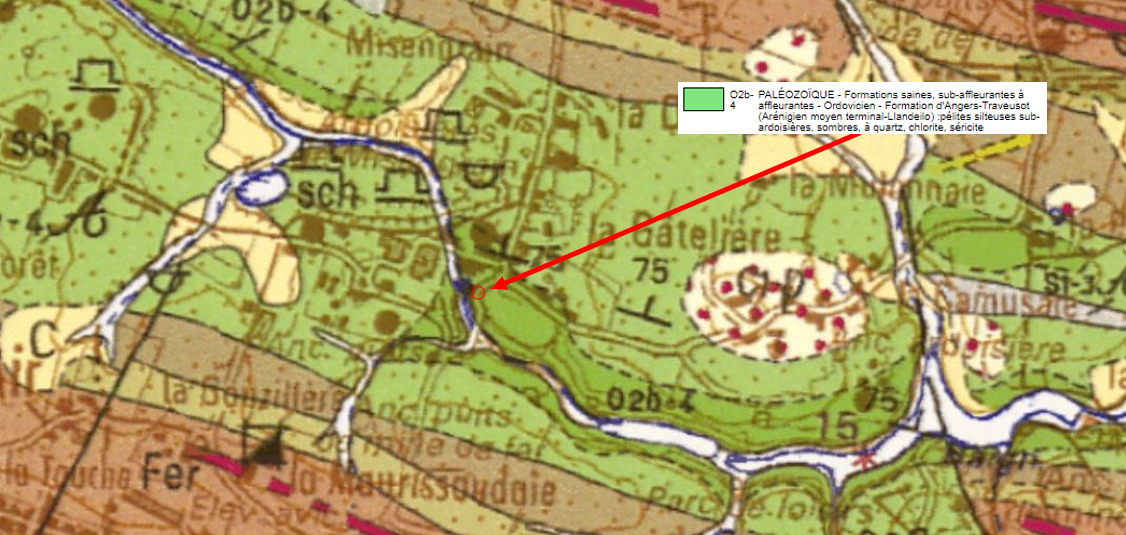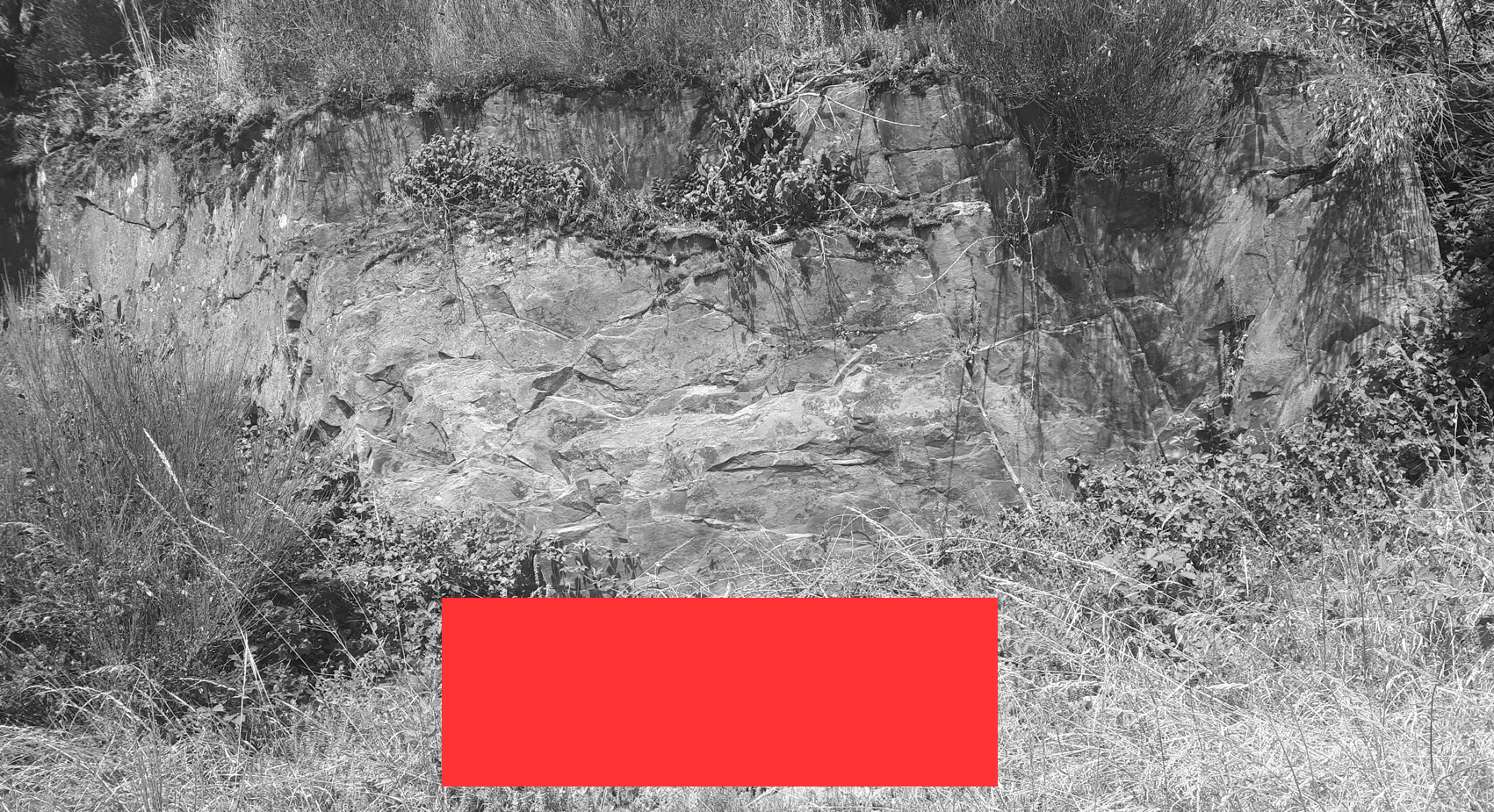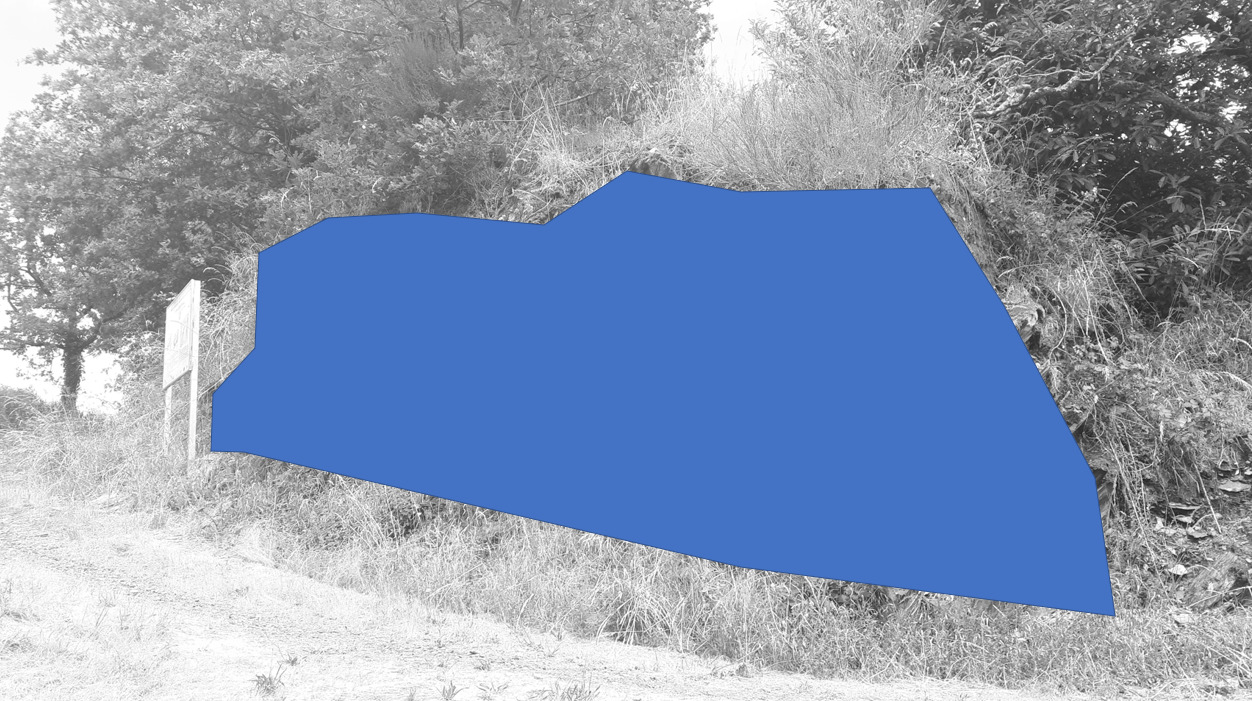
La Earthcache / The Earthcache
► Contexte géologique local
Noyant la Gravoyère est une commune au coeur de l'Anjou Bleu, couleur de la roche qui a façonné ce territoire, les pélites silteuses de l'Ordovicien plus communément appelés "schiste ardoisier".

► Formation
Il y a 500 Ma (Ordovicien), la région de l'Anjou Bleu se trouvait au niveau d'une mer chaude et peu profonde sur le plateau continental du Gondwana.
D'importantes couches de clastes détritiques (principalement des boues argileuses bleutées) se sont déposées au fond de la mer, formant des roches sédimentaires (marnes).
Il y a 450 millions d'années, lors de l'orogenèse varisque, la collision de deux continents a provoqué la formation du massif armoricain.
Sous les pressions et températures, les marnes argileuses se sont métamorphisées en une formation métamorphique, les pélites silteuses.
► Caractéristiques
Les pélites silteuses sont de couleur bleue sombre du fait d'une très forte proportion dans la roche initiale d'argiles bleutées.
C'est une roche à la texture très fine (grains invisibles à l'oeil nu) donnant un toucher très doux quand on la caresse.
La compression a orienté les particules d'argiles dans le même sens, formant une multitude de très minces feuillets conférant une aspect de "mille-feuilles" à la roche dans le sens transversal, et lui donnant un débit esquilleux en ardoises.

► Pendage d'une roche litée, définition et caractéristique
Pour qualifier un pendage d'une couche de roche litée, comme c'est le cas d'une roche comme le schiste ardoisier de Noyant la Gravoyère, il faut déterminer deux valeurs :
- l'inclinaison des lits par rapport à un plan à l'horizontale, exprimée en degrés.
- la direction du pendage, qui se mesure à 90 degrés de la direction de la couche et définit un angle par rapport au Nord.

Cette direction peut prendre des valeurs caractéristiques à un épisode tectonique :
- Direction armoricaine : NW-SE ou W-E. cette orientation est appelée orientation varisque et elle caractérise le plissement hercynien datant du Paléozoïque, et ayant touché l'Ouest de la France.
- Direction alpine ou méridienne : NE-SW ou N-S.
- Direction pyrénéenne ou longitudinale : E-W.
► Local geological context
Noyant la Gravoyère is a commune in the heart of Anjou Bleu, the color of the rock that shaped this territory, the silty pelites of the Ordovician more commonly known as "slate schist"..
► Formation
500 Ma (Ordovician) ago, the Anjou Bleu region was at the level of a warm and shallow sea on the continental shelf of Gondwana..
Significant layers of detrital clasts (mainly bluish clay mud) were deposited on the sea floor, forming sedimentary rocks (marls)..
450 million years ago, during the Variscan orogeny, the collision of two continents caused the formation of the Armorican massif.
Under the pressures and temperatures, the clayey marls metamorphosed into a metamorphic formation, the silty pelites..
► Features
The silty pelites are dark blue in color due to a very high proportion in the initial rock of bluish clays..
It is a rock with a very fine texture (grains invisible to the naked eye) giving a very soft touch when caressed..
The compression has oriented the clay particles in the same direction, forming a multitude of very thin sheets giving a "millefeuille" aspect to the rock in the transverse direction, and giving it a slate-like flow..
► Dip of a bedded rock, definition and characteristic
To qualify a dip of a layer of bedded rock, as is the case of a rock like the slate schist of Noyant la Gravoyère, two values must be determined:
- the inclination of the beds in relation to a horizontal plane, expressed in degrees.
- the direction of the dip, which is measured at 90 degrees from the direction of the layer and defines an angle with respect to the North..
This direction can take on values characteristic of a tectonic episode:
- Armorican direction: NW-SE or W-E. this orientation is called Variscan orientation and it characterizes the Hercynian folding dating from the Paleozoic, and having affected the West of France.
- Alpine or meridian direction: NE-SW or N-S.
- Pyrenean or longitudinal direction: E-W..
► Sources bibliographiques / Bibliographical sources
Les Questions / The Questions
Questions pour valider :"Pélites Silteuses à Noyant la Gravoyère"
Questions to validate: "Silty pelites at Noyant la Gravoyère"
- Question 0 : Prenez une photo de vous ou d'un élément vous appartenant sur le chemin des Ardoisières, mais sans rendre visible les zones d'observations.
Cette photo devra au choix nous être transmise avec les réponses ou être ajoutée à votre log.
-Question 0 : Take a photo of yourself or something belonging to you on the Chemin des Ardoisières, but without making the observation areas visible.
This photo must either be sent to us with the answers or added to your log.
Point 1 : N 47° 42.900 W 000° 57.997
Suivez le chemin des Ardoisières jusqu'au WP1 (affleurement sur la droite du chemin avec des blocs détachés à vos pieds sous la zone rouge). Prenez un de ces blocs.
Follow the chemin des slates to WP1 (outcrop on the right of the path with blocks detached at your feet under the red zone). Take one of these blocks.

- Question 1 : Caressez la zone plane du bloc et décrivez son grain (texture). Est-ce cohérente avec le protolithe de cette roche métamorphique ?
- Question 1: Stroke the flat area of the block and outline its grain (texture). Is this consistent with the protolith of this metamorphic rock?
- Question 2 : Décrivez et qualifiez le débit des blocs à vos pieds.
- Question 2: Describe and qualify the flow of the blocks at your feet.
Point 2 : N 47° 42.894 W 000° 58.006
Avancez jusqu'au WP2 ou se trouve un panneau géologique à côté d'un affleurement transversal de la roche (photo WP2).
Go ahead to WP2 or is a geological panel next to a transverse outcrop of La Roche (Photo WP2).

- Question 3 : Déterminez les deux composants du pendage de l'affleurement sous la zone bleue. La direction du pendage, est-elle cohérente avec l'histoire de cette roche ?
- Question 3: Determine the two components of the outcrop dip below the blue area. Is the direction of the dip consistent with the history of this rock?
- Question 4 : Sur le schéma du panneau, vous pouvez voir le "fil de la pierre". De quoi s'agit-il et quel surnom lui donne t-on ?
- Question 4: On the diagram of the panel you can see the "thread of the stone". What is it and what is its nickname?
Vous pouvez vous loguer sans attendre notre confirmation,
mais vous devez nous envoyer les réponses en même temps soit par mail via notre profil (
fafahakkai), soit via la messagerie geocaching.com (Message Center).
S'il y a des problèmes avec vos réponses nous vous en ferons part.
Les logs enregistrés sans réponse seront supprimés.You can log this cache without waiting for our confirmation, but you must send us the answers at the same time, by e-mail via our profile (fafahakkai) or by the system of Message Center of geocaching.com.
If there is a problem with your answers we will notify you. The logs recorded without answers will be deleted.
Rappel concernant les « Earthcaches »: Il n'y a pas de conteneur à rechercher ni de logbook à renseigner. Il suffit de se rendre sur les lieux, de répondre aux questions ci-dessus et de nous renvoyer les réponses.
Reminder concerning "Earthcaches": there is neither a container to look for nor a logbook to sign. One need only go to the location, answer to the differents questions and send us the answers.